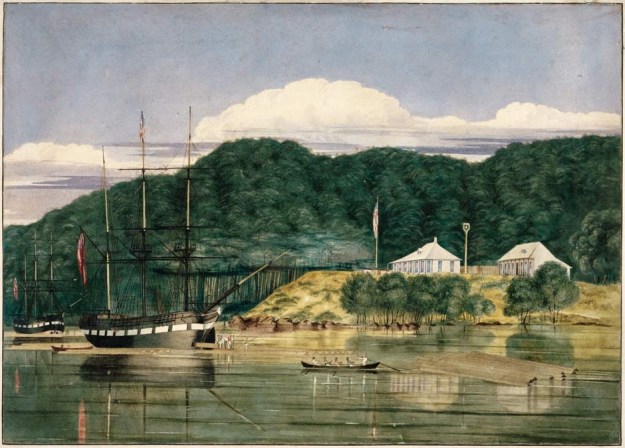I have recently read the book titled Hokianga by Jack Lee. It has provided some in site to the early european settlement in the Hokianga. It covers the lives of the early settlers and their family’s like McDonnell, Russell, Maning, Clark, Polack, Polynton, Cassidy, Marmon, White, Marriner and many more.
From the book we discover that McDonnell, Russell and White were the three main players in the local timber trade, with McDonnell and White constantly feuding with each other on the south side of the upper Hokianga and Russell on the north side based out of Kohukohu.
Of most interest were the Russell’s and the Marriner’s both of whom eventually settled in Kohukohu, on the northern banks of the upper Hokianga. Marriner Street in Kohukohu is named after the family. It was the Marriner’s whom John befriended and it appears they became life long friends, both in Hokianga and later in the Kaipara.
George Frederick Russell had sailed from Sydney to Horeke in 1831. He then in 1839, purchased properties in Kohukohu, setting up his own business as a timber trader, shipping kauri spars and squared timber to London and other markets.
It was George Russell, as we have come to discover, who first employed our John Stanaway perhaps it was when Russell set up his business in Kohukohu that he needed an experienced hand at loading ships rather than just a sawyer. Maybe he even travelled back to Australia to find a man to fit the bill, maybe at the same time John was looking for work and the two men met.
Perhaps it was this employment opportunity which bought John James Stanaway to New Zealand and why he settled initially in the Hokianga. It may be why he could afford to bring his pregnant wife, he may not have been having to rely on being self-sufficient rather he had a place of employment already organised and shelter of some sort was offered by George Russell.
George Russell died in 1855 aged in his mid forties, the only lasting traces of George Russell are the cannons he purchased for defence of his by then small settlement in 1845 during the Heke Wars these are now tourist attractions.

A particular painting I would like to bring to your attention. It is Charles Heaphy’s painting of Kohukohu on the Hokianga Harbour, painted in 1839. It shows G. F. Russell’s house and timber yard at Kohukohu, with a ship and a barque, the Francis Spaight (nearer vessel) and the Bolina (on the left) loading kauri spars; and a row-boat hauling spars. On the hill behind is dense native forest (Credit: Alexander Turnbull Library ref C-025-020).
It is possible that included within this paint is our John James Stanaway, either in one of the two rowing crews or in the loading gang.



 Last week we were contacted by a potential branch of the Stanaway family which, to date we did not know existed – or rather, the reseach into this side had in the Tides of Time family tree, had only been able to go so far.
Last week we were contacted by a potential branch of the Stanaway family which, to date we did not know existed – or rather, the reseach into this side had in the Tides of Time family tree, had only been able to go so far.



